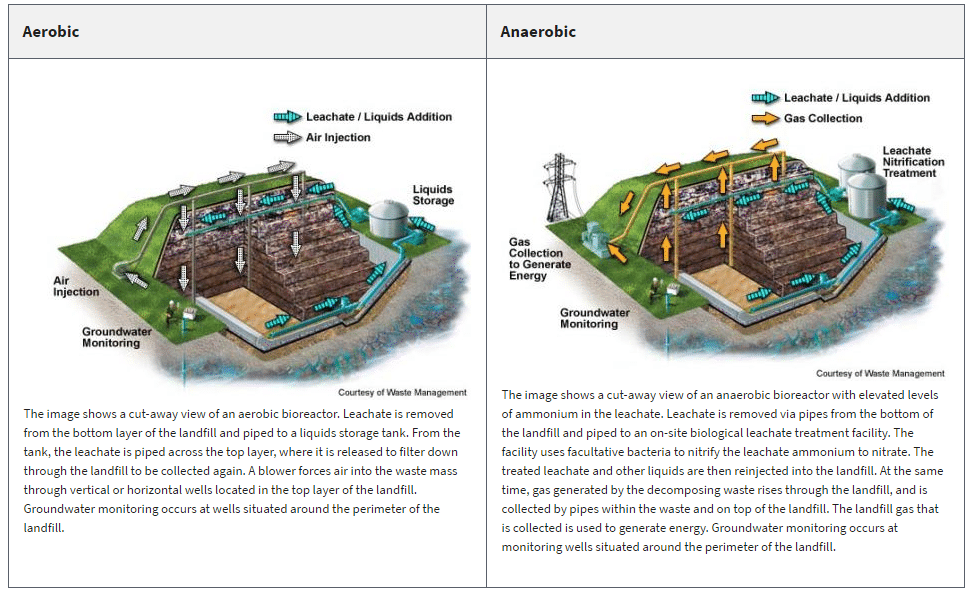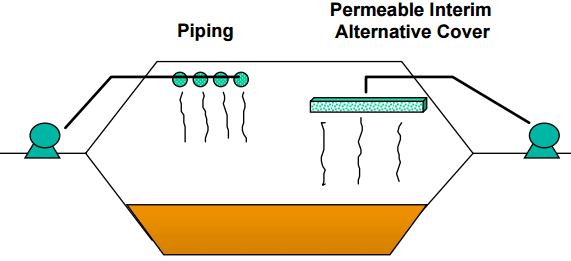BIOREACTOR LANDFILLS

Abs: A bioreactor landfill is a MSWLF that operates to rapidly transform and degrade organic waste. The increase in waste degradation and stabilization is accomplished through the addition of liquid and air to enhance microbial processes. This bioreactor concept differs from the traditional “dry tomb” municipal landfill approach.
The future of landfill management is the construction of Bioreactor Landfills that are an environmentally sound system for solid waste disposal. These landfills are constructed to enhance the degradation and stabilization of the waste material which reduces potential threats to human health and the environment. Bioreactor landfills degrade and sequester waste materials resulting in leachate which does not contain toxic contaminants above standards. The recirculation of the landfill leachate accelerates the decomposition of the waste and generation of landfill gas. Sufficient experience now exists in the solid waste field to recommended design and operating practices.
The advantages of Bioreactor Landfills include:
- Efficient utilization of permitted landfill capacity
- Stabilization of waste in a shorter time
- Reduced leachate handling cost
- Reduced post closure care
- Potential for landfill gas to be a revenue stream
- Reduced air emissions containing VOC and HAPs
- Obtaining an advantage from alternative cover designs
- Reduced toxicity of leachate and waste material
- Consistency with sustainable landfill design
There are three general types of bioreactors:
- Aerobic – Leachate is recirculated with additional water and air.
- Anaerobic – Leachate is recirculated with additional water but no air is added
- Hybrid – Uses sequential aerobic/anaerobic methods to degrade the waste material and generate gas faster.

The principal design element that is added in a bioreactor landfill is the leachate recirculation system. In a conventional landfill, leachate is directed to a treatment facility after being pumped from the landfill. With a bioreactor, various methods are used to reinject the leachate into the waste’s top layers.
There are several methods of reintroducing leachate into the landfill environment, depending on specific site conditions. Spray irrigation, surface application, vertical well injection and horizontal well injection are used. Factors such as ease and cost of installation, waste quantity, and climate will affect which method is chosen.

Conventional landfills do not generate enough leachate to maintain high moisture content so additional liquids need to be added. This can be either water or other non-hazardous liquids such as:
- Liquid amendments that are between pH of 4 to 9 and must be non-hazardous by characteristic and definition
- Liquids amendments that are 95-99% aqueous
- Liquid amendments currently accepted by bioreactor demonstration sites are
- biosolids (2 to 9 % fresh or treated sewage sludge from POTWs (Publicly Owned Treatment Works (from raw sludge, digestors or lagoon clean-outs)
- liquid rejects from food and beverage manufacturers
- paint rejects or paint spray booth materials (acrylic water based paints)
- tank clean-outs and oily waters (95% aqueous)
- antifreeze waters, dye and ink test waters, dry well water
- leachates from other sites
- liquid sludge from non-hazardous waste treatment plants (commercial and industrial)
- remedial liquids from companies that specialize in remediation and transport
- High concentration of soluble and degradable organic liquids
Liquids not acceptable include:
- Surfactant based fluids, oil or petroleum based fuels, pickling wastes, aluminum dross, and high sulfur content wastes
- Liquids that can be degraded quickly to simple sugars, such as tomato food rejects, should be used in combination with other aqueous amendments to avoid rapid fermentation to volatile acids
- Liquids with total phenols > 2000 ppm
- Liquids that are sulfide or cyanide reactive, ignitable, or corrosive
- Liquids that may be classified as hazardous waste or substances
Sufficient experience now exists to define recommended design and operating practices
Design considerations include:
- Liner systems (using low permeability material such as natural clay or manmade geo-membranes) A composite liner consisting of a geomembrane and a clay layer is used in convectional landfills. A double composite liner system may also be used, which further prevents the escape of leached leachate to the environment. http://www.gseworld.com/Products/
- Leachate collection and recirculation systems – Leachate collection system: The leachate collection system should be designed carefully and efficiently to collect, remove and manage leachate. It should be designed such a way that it can collect higher volume of water, as recirculation is being practiced in bioreactor landfills i.e., the size of the pipe or the pumping capacity will be greater than in case of convectional landfills. In case of enhanced biodegradation activity, there are chances for the fine particles to clog and so the filter and operational layers should be designed around the leachate collection pipe system. http://www.epgco.com/
- Gas collection and control systems – The accelerated decomposition of waste in the bioreactor landfills makes it mandatory that the gas collection system should be installed from the early phase of the landfill operation. http://www.prm-net.com/landfill-gas-equipment
- Daily Cover – Should not impede downward movement of liquids or gas capture the cover material can be mixed with agricultural wastes such as composted yard wastes, etc. These materials degrade and can be placed over the solid waste lifts. Other alternative cover materials include polymer foams, slurry sprays, sludge, reusable geosynthetics and geotextile. The geotextile has a higher advantage compared to these other materials. i.e. It can control the rate of precipitation and infiltration into the landfill. For bioreactor landfills, a final cover may not be placed until most of the settlement has occurred. Instead, a temporary cover may be placed.
Bioreactor Operation Considerations:
Liquid Recirculation – To optimize the effectiveness of a liquids recirculation program, one operator has found that dosing the landfill rather than continuous application was more beneficial. Dosing was accomplished by intermittently injecting liquids into the landfill trenches. This is done by letting the liquids seep into the landfill and then applying additional liquids to the trenches on a periodic basis.
Daily Cover – Recirculated liquid must be free to move within the landfill. Highly compacted soil daily cover creates barriers within the landfill. Options for daily cover that are more compatible with recirculation include tarps, plastic sheeting, and foam. It is also possible to use a highly permeable cover such as sand or to strip the daily cover off at the beginning of each new working day. For recirculation and bioreactor sites, it may be helpful to slope the daily cover (or top of trash) surface back in towards the landfill.
Working Face – The working face should be pre-wetted. Pre-wetting the waste at the working face has the advantages of increasing the moisture content of the waste, improving compaction and reducing windblown litter.
Landfill Gas – Bioreactors generate LFG earlier in the process and at a much higher rate than the traditional landfill. Bioreactor LFG is generated over a shorter period of time because the LFG emissions begin early and decline as the accelerated decomposition process depletes the source waste.
Final Cover – The timing for application of final cover will have to be considered in light of operational and permit requirements. To take advantage of the airspace increase created by liquids recirculation, the cell should stay open without a final cap as long as possible.
Odor – An aggressive odor control plan should be developed for virtually all landfills, but it is essential for recirculation/bioreactor operations. Some operators have experienced increased odor problems that seem to be related to the recirculation of leachate.
Compaction – The highly compacted (tight) layers of trash reduce the ability of moisture to evenly saturate the mass and may cause problems with leachate outbreaks. To optimize recirculation effectiveness, it may be more efficient to do an initial loose compaction and then follow at some later time with more rigorous compaction (top 40-50 feet) after moisture has been well distributed.
Winter Operations – Liquids recirculation can be continued in winter months, particularly in buried pipe distribution systems. It may be necessary to provide freeze protection to aboveground components of the system.
Landfills will continue to play an important part in the management of solid waste. With the advent of the design and construction of Bioreactor Landfills the problems such as contaminated leachate, air pollution, reduced closure cost, and being consistent with sustainable design will further protect human health and the environment.






